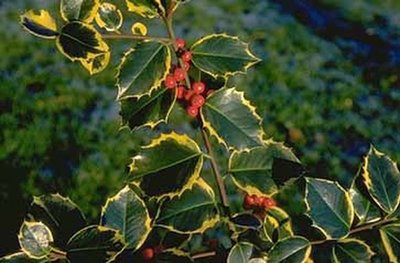May 11, 2006
Holly’s folly: New Arboretum design isolates invasive species while giving others room to grow
A new home for the hollies — the design for which includes both elegant and humorous elements — is being planned at the Washington Park Arboretum, a part of the University of Washington Botanic Gardens.
Designed by associate professor Iain Robertson, the garden includes:
- space for relocating 40 species of holly already at the arboretum,
- room to grow after a UW Botanic Garden expedition to China planned for 2007,
- a place to symbolically “cage” the species of holly that has the potential to be a nasty competitor for native trees and plants.
Ironically that’s the very species many people think of as holly: the Christmas-time evergreen with dark green, spiny leaves and brightly colored berries. Unfortunately Ilex Aquifolium, or English holly, can grow in the darkest conditions like those in the Northwest’s native forests, and birds eating the berries have spread it to places it doesn’t belong.
English holly has, for instance, become a serious pest in the Olympic National Park and forest and, in an urban setting, the Seattle Urban Nature Project puts holly as the No. 1 scourge of parks after ivy.
Thus Robertson’s design includes a “garden folly.” A folly is a structure or area quirky enough to make one stop and ask, “Who dreamed this up?” In this case a specimen of English holly will sit isolated, “caged off” from the rest of the collection. It has yet to be determined what form the cage will take. It could, for example, be pieces of broken concrete around the base of the holly, symbolizing that it should be walled off.
Robertson, from the Department of Landscape Architecture, says he hopes the design gives people pause, reinforcing the educational information at the site urging gardeners and landscapers to think carefully about what kinds of hollies they use.
“Iain’s design not only meets our requirements as stewards of a world-class collection of hollies, but also provides an elegant, interesting and humorous display which I believe to be not only distinguished, but highly original,” says professor David Mabberley, director of the UW Botanic Gardens, a part of the UW College of Forest Resources. Mabberley says that in terms of species, the UW’s collection of hollies is second in the nation only to the National Arboretum in Washington, D.C.
This area may actually have the mild weather suited for an even wider collection. There are about 400 holly species worldwide, most of them in the tropics. Any of the species from temperate climates should be able to grow here, Mabberley says, adding that hollies are excellent plants for use as screens and hedges.
The bulk of the current holly collection is at the south end of the arboretum on a site it shares mainly with big leaf maples. That area is to be remade with gardens featuring plants from around the Pacific Rim, according to the arboretum master plan hammered out in recent years and approved by the UW regents and the city.
Plans for the Pacific Rim gardens trigger a cascade of changes, the first of which will be moving the hollies from the south end, and elsewhere in the arboretum, to a site at Interlaken Avenue East and Lake Washington Boulevard East. Hollies too large to move will be propagated. The English hollies that will be removed will be cataloged in the UW’s herbarium. Lilacs displaced by the consolidation of the holly collection are being propagated and will find a new home on Azalea Way where they should prosper under the sunnier conditions, Mabberley says.
Robertson’s challenges in designing a garden for the hollies at their new site included considering site conditions so the plants can thrive. With a great deal of surface and subsurface water, Seattle Public Utilities was consulted and a plan developed to incorporate swales ¬– broad, shallow channels — where native plants will be grown as a cost-effective way to manage excess water at the site.
“Using natives in swales also responds to the arboretum master plan’s goals of a native-forest-matrix backdrop to collections and the swales are designed to separate the various beds of the collection into areas from different parts of the world so that the taxonomic arrangement of the collection is made clear,” Roberston says.
The genus is divided into “clades,” or subdivisions, according to what’s understood of the taxonomic relationships of species, he says. The clades are American, Asian-North American, Deciduous and Eurasian. These are partially related to geographic location and partially to the morphological difference between deciduous and evergreen species.
One of his biggest challenges was considering the species that may be added to the collection in the future, for some of which taxonomists have yet to determine the proper clade.
“I made the decision on where these species may be placed based exclusively on place of origin,” he says. “It is an example of the many unknowns that we had to contend with in developing the design — in this case an unknown that relates directly to the educational message of the collection.”



